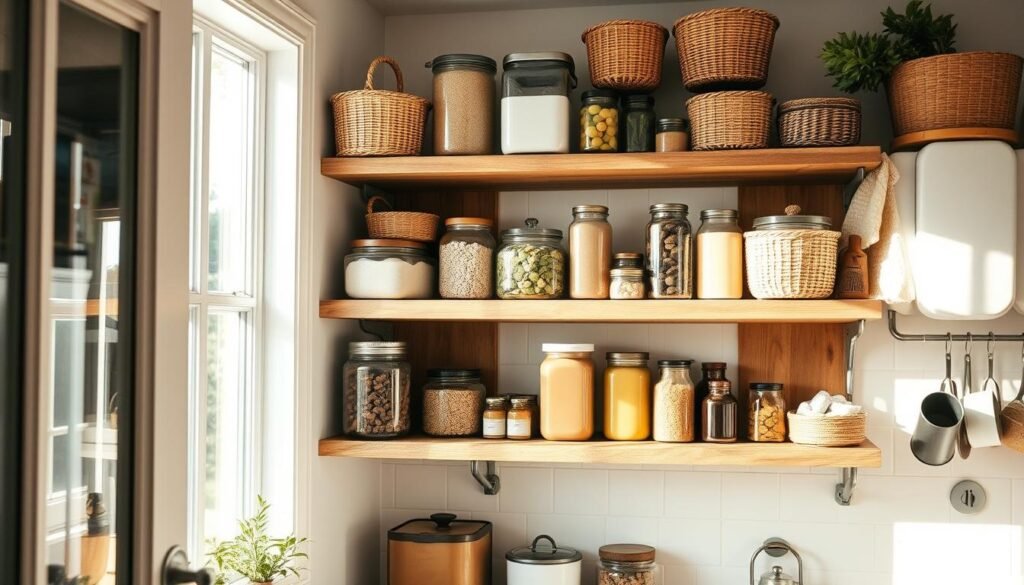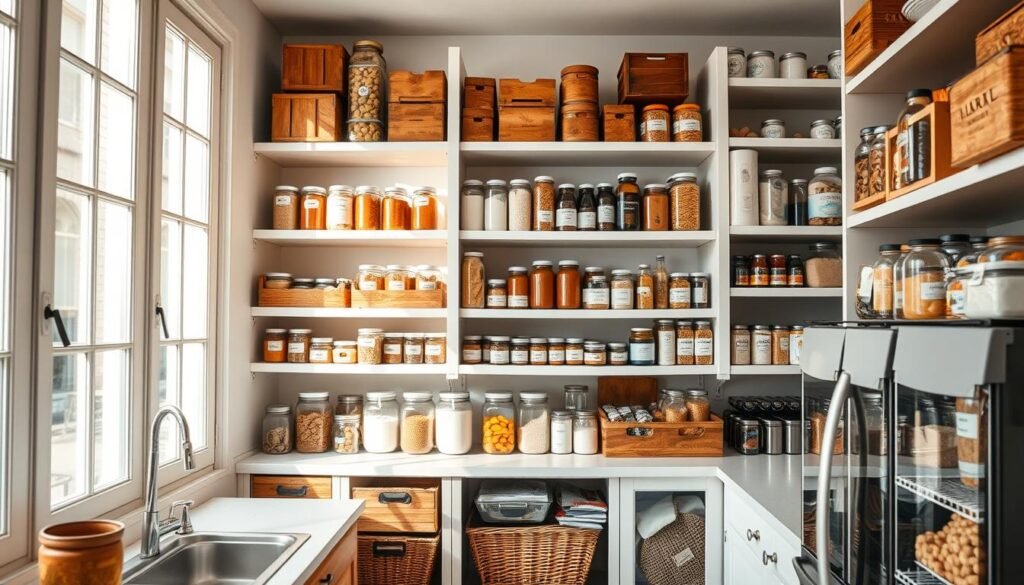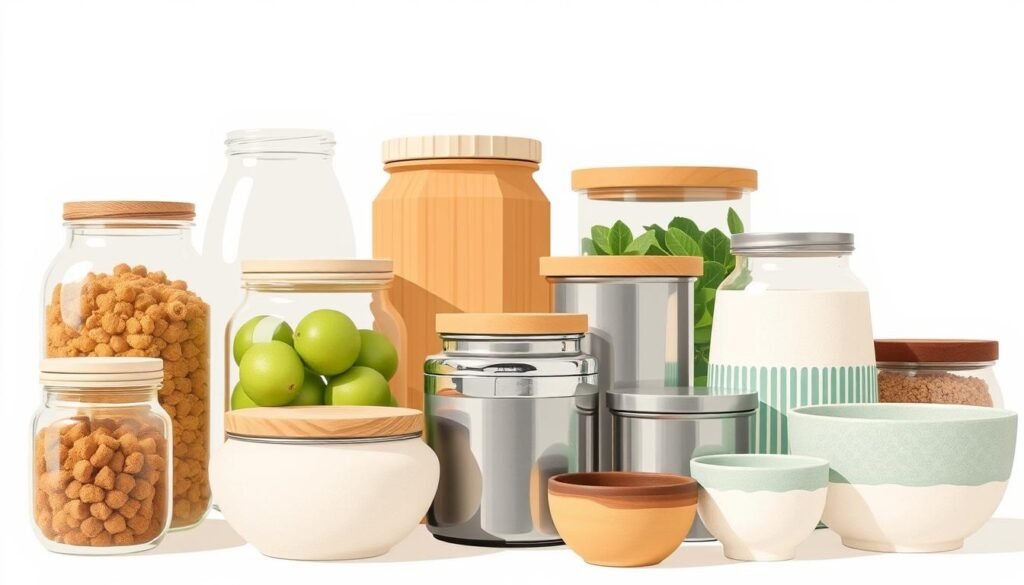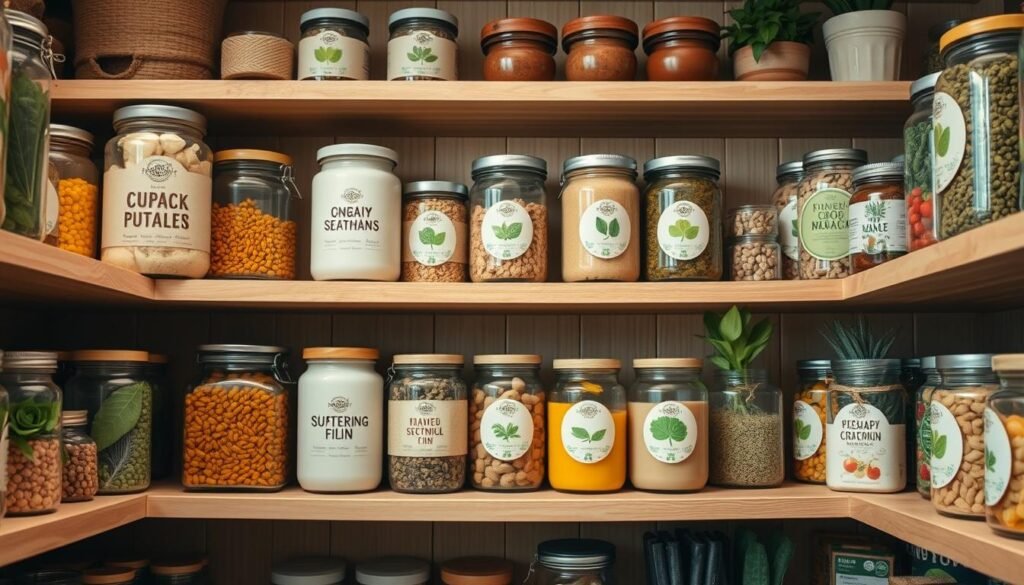
Did you know that household food waste accounts for roughly 40-50% of all food waste in the United States? This staggering statistic highlights the significant impact our kitchens have on the environment. By transforming your kitchen into a more organized and clutter-free space, you can make a substantial difference.
A well-organized pantry is key to reducing waste and creating a more functional space. By implementing sustainable practices, you can minimize food waste and create a more efficient cooking environment.
Key Takeaways
- Transforming your pantry can significantly reduce household waste.
- Practical, eco-friendly solutions can make organizing your pantry both sustainable and aesthetically pleasing.
- A well-organized pantry supports healthier eating habits and a more sustainable lifestyle.
- Small changes in pantry organization can lead to significant environmental benefits and cost savings.
- A clutter-free kitchen space enhances your overall cooking experience.
The Environmental Impact of Kitchen Clutter

Kitchen clutter isn’t just an eyesore; it has a significant environmental impact. The state of your pantry and kitchen organization plays a crucial role in determining your household’s food waste and overall environmental footprint.
Food Waste Statistics in American Homes
According to the EPA, household food waste accounts for roughly 40-50% of all food waste in the United States. This staggering statistic highlights the importance of addressing kitchen clutter. When your pantry is disorganized, it’s easy to overlook expired or spoiled items, leading to unnecessary waste.
How Disorganized Pantries Contribute to Waste
A cluttered pantry can lead to a cycle of waste that extends beyond just food items. Expired products often hide in the clutter, resulting in duplicate purchases and increased household waste. Moreover, the packaging waste from kitchen products compounds environmental issues, affecting your overall lifestyle and choices.
By understanding the correlation between disorganized pantry spaces and increased food waste, you can take the first step towards creating a more sustainable kitchen environment. Organizing your pantry is not just about aesthetics; it’s about reducing waste and living more sustainably.
Benefits of Creating a Sustainable Pantry
Embracing sustainability in your pantry can lead to a more organized, healthier, and environmentally conscious kitchen. By making a few simple changes, you can significantly reduce your environmental footprint while improving your cooking experience.
Reducing Food and Packaging Waste
A well-organized pantry naturally reduces food waste by improving visibility and accessibility of items. You’ll be able to see what you have and avoid buying duplicates. Sustainable storage solutions, such as reusable containers, minimize packaging waste, further reducing your environmental impact.
Saving Money Through Better Organization
A sustainable pantry can help you save money in several ways. By reducing food waste and avoiding duplicate purchases, you’ll lower your grocery bills. Additionally, using reusable products and containers can save you money over time.
Creating a Healthier Kitchen Environment
An organized pantry system makes meal planning easier, leading to healthier eating habits. By having a clear view of your ingredients, you’re more likely to cook at home and make healthier choices. This, in turn, can minimize ultra-processed foods and toxins in your diet.
By creating a sustainable pantry, you’re not only contributing to environmental efforts but also creating a more pleasant cooking environment. This can encourage home-cooked meals over takeout, further enhancing your kitchen experience.
Step 1: Assess Your Current Pantry Situation

Let’s start your sustainable pantry journey by taking stock of what you have. The most sustainable pantry is the one that uses what you already have, rather than throwing everything out and starting from scratch.
Inventory of Pantry Essentials
Taking inventory of your pantry items is the first step towards a more organized and sustainable kitchen. By doing so, you’ll be able to identify what you have, what you use, and what you can salvage.
- Create a list of the essentials you have in your pantry.
- Note any duplicates or multiples of certain items.
- Identify any expired or near-expired food that needs attention.
Identifying Problem Areas
As you assess your pantry, pay attention to any problem areas or sources of waste. This could be due to inefficient storage, overbuying, or poor food rotation.
By recognizing these patterns, you can make informed decisions about how to improve your pantry’s organization and reduce waste.
Creating a Pantry Checklist
A customized pantry checklist will help you stay on track and ensure that you’re using what you have. This step is crucial in maintaining a sustainable pantry.
By following these steps, you’ll be able to take control of your pantry and make the most of the things you already have.
Step 2: Declutter and Clean Your Pantry Space

To achieve a sustainable pantry, you need to start by decluttering and cleaning the space. This step is crucial in creating a clutter-free kitchen environment that promotes efficient meal preparation and reduces food waste.
Sorting and Consolidating Items
Begin by taking everything out of your pantry and sorting items into categories. This will help you identify what you have, what you need, and what can be discarded or donated. Be sure to check expiration dates and the condition of your food products.
Proper Disposal of Expired Foods
Dispose of expired or spoiled food items responsibly. Consider composting organic waste to reduce your environmental footprint. If you have unopened, non-perishable items that are still good, consider donating them to a local food bank or pantry.
Eco-Friendly Cleaning Methods
Once you’ve purged your pantry, it’s time to clean. Use eco-friendly cleaning products or a mixture of vinegar and water to wipe down shelves and clean containers. This will help remove any residue and bacteria, ensuring a fresh start for your pantry.
| Cleaning Method | Eco-Friendliness | Effectiveness |
|---|---|---|
| Vinegar and Water | High | High |
| Eco-Friendly Cleaning Products | High | High |
| Chemical-Based Cleaners | Low | High |
By following these steps, you’ll be able to create a clean, organized, and sustainable pantry space that makes meal preparation easier and reduces waste.
Step 3: Choose Sustainable Pantry Solutions for Storage

The key to a sustainable pantry lies in the storage solutions you choose, so let’s explore your options. When it comes to storing food and kitchen essentials, the containers you use can make a significant difference in reducing waste and maintaining organization.
Glass Jars and Containers
Glass jars are an excellent choice for pantry storage. They’re non-toxic, durable, and can be used for a variety of foods. You can repurpose jars you’ve collected from food purchases, like those big jars of sundried tomatoes or beetroot. Simply give them a wash, and they’re ready for use. Glass containers are also great for showcasing your pantry contents, making it easier to see what you have.
Stainless Steel and Other Plastic-Free Options
If glass isn’t your preference, consider stainless steel containers or other plastic-free alternatives like ceramic or bamboo. Stainless steel is durable and resistant to corrosion, making it ideal for storing dry goods. Ceramic bowls with lids are another attractive option, adding a touch of elegance to your pantry while keeping contents fresh.
Repurposing Existing Containers
Before buying new containers, think about repurposing what you already have. Those stainless steel containers lying around can be perfect for storing food. You can also visit second-hand shops to find affordable, eco-friendly storage solutions like Pyrex bowls. This approach not only reduces waste but also saves you money.
By choosing the right storage solutions, you can enhance your pantry’s functionality and aesthetics. Whether you opt for glass, stainless steel, or repurposed containers, the goal is to create a space that’s both organized and sustainable.
Step 4: Implement a Sustainable Organization System

Creating a sustainable pantry organization system is about being intentional with your storage and access. It’s not just about making your pantry look good; it’s about creating a functional space that supports your cooking habits and reduces waste.
Grouping Similar Items Together
Start by categorizing your pantry items into groups, such as grains, spices, and canned goods. This makes it easier to find what you need and prevents duplicate purchases. Labeling your categories can also help maintain the system.
Creating Zones Based on Usage Frequency
Organize your pantry into zones based on how often you use certain foods and items. For example, frequently used ingredients like olive oil and spices should be easily accessible, while less frequently used items can be stored on higher shelves or towards the back.
Maximizing Vertical Space
Make the most of your space by using stackable container systems and wall-mounted solutions. This not only increases your storage capacity but also keeps your pantry floor clear, making it easier to clean and navigate.
By implementing these strategies, you’ll create a pantry that’s not only organized but also sustainable. This approach will help reduce waste and make cooking more efficient.
| Organization Strategy | Benefits |
|---|---|
| Grouping similar items | Easier to find items, reduces duplicate purchases |
| Creating zones based on usage | Improves accessibility, reduces waste |
| Maximizing vertical space | Increases storage capacity, improves navigation |
As you organize your pantry, remember that the goal is to create a system that works with your habits, not against them. By doing so, you’ll maintain a sustainable pantry that’s both functional and enjoyable to use.
“A place for everything, and everything in its place” is a mantra that can guide your pantry organization efforts. By assigning a home for each item, you’ll reduce clutter and make meal prep more efficient.
Step 5: Develop Eco-Friendly Labeling Methods

You can make your pantry more efficient and environmentally friendly with the right labeling techniques. Labeling your containers and bags is a simple yet effective way to keep track of what you have, making it easier to find what you need without rummaging through everything.
Compostable Stickers and Tags
One of the most sustainable labeling options is using compostable stickers and tags. These are made from materials that can easily decompose, reducing plastic waste in your kitchen. You can use these labels on your jars and containers to keep them organized without harming the environment.
Reusable Label Options
For a more durable solution, consider reusable labeling options. Chalkboard paint, wax pencils, and erasable markers are great alternatives that allow you to label and relabel your labels as needed. This approach not only reduces waste but also gives you the flexibility to change your labels whenever you need to.
Tracking Expiration Dates Sustainably
It’s also important to track expiration dates to reduce food waste. Using eco-friendly labels or markers to note the dates on your products can help you keep track of what needs to be consumed first. This way, you can manage your pantry contents more effectively, saving time and reducing waste.
By implementing these eco-friendly labeling methods, you’ll not only keep your pantry organized but also contribute to a more sustainable kitchen environment. Whether you’re labeling jars, containers, or bags, the key is to find a system that works for you and stick to it. Proper labeling can significantly reduce food waste by improving visibility and awareness of your pantry contents, making it easier to manage your kitchen efficiently.
Step 6: Adopt Sustainable Shopping Practices

To maintain a sustainable pantry, it’s crucial to adopt eco-friendly shopping habits that reduce waste and save money. By making a few simple changes to your grocery shopping routine, you can significantly minimize your environmental impact.
Buying in Bulk to Reduce Packaging
One effective way to reduce packaging waste is by buying food in bulk. Purchasing items like grains, legumes, nuts, and spices in bulk not only reduces packaging waste but also saves you money in the long run. Consider shopping at stores that offer bulk bins and use your own reusable bags or containers to fill up.
Using Reusable Bags and Containers
Using reusable bags and containers is another simple yet effective way to reduce waste when shopping for groceries. Bring your own bags to the grocery store and choose products with minimal or biodegradable packaging. You can also use cotton bread bags to store your loaves, keeping them fresh while reducing plastic waste.
Planning Purchases to Minimize Waste
Planning your food purchases carefully can also help minimize waste. Make a list before you go to the store and stick to it to avoid impulse buys that may go to waste. Consider meal planning and using up leftovers to reduce waste further and save on your grocery bills.
By implementing these sustainable shopping practices, you’ll not only reduce your environmental footprint but also create a more efficient and organized pantry. Start by making small changes and gradually work your way up to more significant adjustments.
Step 7: Maintain Your Sustainable Pantry
To keep your pantry sustainable, you’ll need to implement a few simple habits that make a big difference over time. Maintaining your pantry is not about perfection; it’s about creating sustainable habits that work for your lifestyle.
Regular Inventory Checks
Regular inventory checks help you stay aware of what you have and what needs to be used. By doing this, you can avoid buying duplicate items and reduce food waste. It’s a good idea to schedule these checks every few months to keep your pantry organized.
Rotating Stock to Prevent Waste
Rotating your stock ensures that older items get used before newer ones. This can be achieved by placing newer items at the back of the shelf and bringing older items to the front. You can also use the “first-in, first-out” rule to minimize waste.
Seasonal Pantry Refreshes
Seasonal pantry refreshes help you align your pantry with changing cooking patterns throughout the year. For example, you can stock up on summer spices during the spring or prepare for holiday baking in the fall. This keeps your pantry relevant and organized.
Let’s look at some practical strategies for maintaining your pantry:
| Strategy | Description | Benefit |
|---|---|---|
| Double Batching Dry Goods | Make double batches of dry ingredients for recipes like cookies or biscuits | Saves time and reduces dishes |
| Using Dehydrated Ingredients | Utilize dehydrated ingredients like dried mushrooms and vegetable broth powder | Prevents food waste and adds convenience |
| Freezing Leftover Items | Freeze leftover tomato paste, veggie broth, and other items into ice cubes | Reduces waste and makes meal prep easier |
By implementing these strategies, you can maintain a sustainable pantry that is organized, efficient, and eco-friendly. Remember, the key is to create habits that work for you and your lifestyle.
Conclusion: Embracing a Sustainable Kitchen Lifestyle
As you transform your pantry into a sustainable space, you’re not just decluttering your kitchen; you’re embracing a lifestyle that benefits the planet. By adopting sustainable pantry solutions, you’re reducing waste and promoting eco-friendly living.
A sustainable pantry is about more than just food storage; it’s about creating a healthier kitchen environment and minimizing your environmental footprint. Using containers and storage solutions that are free from plastic and other harmful materials is a great start.
Remember, the goal isn’t perfection – it’s progress. By making small changes to how you organize and maintain your kitchen goods, you’re contributing to a more sustainable lifestyle. Share your journey with others to inspire positive change and create a ripple effect of eco-friendly practices in your community.
FAQ
What are the best containers for storing dry goods like flour and sugar?
Glass jars and containers are ideal for storing dry goods because they are airtight, non-toxic, and can be reused multiple times. Look for containers with tight-fitting lids to keep your flour and sugar fresh.
How can I reduce food waste in my kitchen?
To reduce food waste, start by taking inventory of what you have, and then plan your meals around those ingredients. You can also use up leftovers or freeze items that are approaching their expiration dates. Proper storage and labeling can also help you keep track of what’s in your pantry.
What are some eco-friendly ways to label my pantry items?
You can use compostable stickers, reusable labels, or even chalkboard labels to identify the contents of your containers. These options are not only eco-friendly but also easy to use and reusable.
How often should I clean and declutter my pantry?
It’s a good idea to clean and declutter your pantry every few months to get rid of expired or spoiled food and to reorganize your storage. You can also do a seasonal refresh to update your pantry organization and get rid of items you no longer need.
Can I repurpose existing containers for my pantry?
Yes, you can definitely repurpose existing containers for your pantry. Just make sure to clean them thoroughly and dry them before using them to store food. You can also get creative with containers you might otherwise throw away, like turning old jars into spice containers.
How can I maximize my pantry storage space?
To maximize your pantry storage space, consider using stackable containers, baskets, or shelves to make the most of your vertical space. You can also group similar items together and create zones based on usage frequency to make it easier to find what you need.
What are some benefits of buying in bulk?
Buying in bulk can help reduce packaging waste, save you money in the long run, and ensure that you have a steady supply of your favorite ingredients. Just be sure to store your bulk purchases properly to maintain their freshness.
